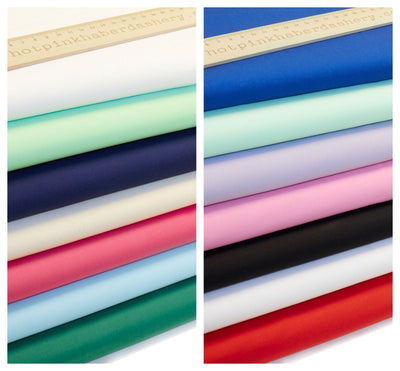The History of Organza - from the Silk Road to your wardrobe
What Is Organza?
Organza is a lightweight, sheer, plain weave fabric, originally made from silk. Today, many contemporary organzas are made from synthetic materials such as polyester and nylon, providing consumers with an ever greater affordable, versatile and durable choice of fabrics.
Organza is defined by the tiny holes throughout the fabric, created by the gaps between the weft and warp thread in the plain-weave material. The quality of organza is determined by the number of holes per inch and the greater number of holes denotes a higher standard of organza. Organza is the go-to fabric for bridal gowns and evening wear, due to it’s shimmery, delicate quality which creates a luxurious drape and a stunning silhouette.
Where Did Organza Originate From?
The name organza originally stems from the word organzine, which refers to the process of making silk threads by twisting the silk fibres. Although silk originated in China, the word organzine comes from the town of Urgang in Turkestan, which was home to one of the most popular silk markets on the Silk Road.
Organza arrived in Europe from China, via the Silk Road and has remained a desirable dress-making fabric ever since. Whilst China is still the largest producer and exporter of organza today, the production of this beautiful fabric has spread across the world. Silk organza is produced in France and Italy and remains a luxurious fabric choice for high-fashion gowns and beautiful bridalwear.
How Is Organza Made?
Making organza involves a complicated and delicate weaving process and many types of organzas are still made by hand due to the precise nature of the work involved.
The weaving process begins by using filament yarns – long, continuous strands of either silk or synthetic fibres which are twisted tightly in opposite directions so the fibres naturally cling together. Once the yarns are twisted together, they are combed and treated with acid which will create the character stiffness of organza. These treated yarns are spun into fabric and woven together using a plain weave method. Here the warp and weft threads are criss-crossed in an equal pattern to form the correct appearance, drape and finish for organza.
What Is the Difference Between Organza, Chiffon and Tulle?
Organza, chiffon and tulle often cause some confusion as they share very similar qualities. All three fabrics are delicate, sheer and gauzy making them ideal for bridalwear and dress-making.
Organza differs from chiffon and tulle by having a stiffer, stronger weave which can create more volume & structure. Organza has a smooth, shiny appearance that is perfect for dress-making & fashion pieces, bridalwear as well as soft furnishings and theatre designs.
Tulle is often referred to as silk mesh due to its tiny netting appearance and has more elasticity than organza. Originating from the town of Tulle in France, this pretty fabric is known for its beautiful drape and is often used for bridal veils, petticoats, dress overlays and trims.
Chiffon has a very fine, delicate weave and the softest drape of the three fabrics. It doesn’t wrinkle easily and creates a flowing movement when used in dress-making.
What Are The Qualities Of Organza?
Organza is a sheer, transparent material due to the tiny holes created by its fine weave. The quality of organza is defined by whether it is made from silk or synthetic fibres as well as the number of holes per inch within the weave. These holes also make the material very breathable, as they allow air to pass through more easily, making this a suitable fabric for summer days and warmer climates. The acid treatment and twisted fibres used during the production of organza create the delicate sheerness of this fabric. As a result, organza reflects and shimmers beautifully in the light adding to its ethereal quality and, of course, making it a perfect choice for elegant wedding dresses and evening gowns. Organza’s characteristic stiffness, created by the acid treatment of the yarns, brings a structured drape and volume to the material. This stiffer quality is ideal for dressmakers and designers looking to achieve a structured silhouette.
What Is Organza Used For?
Organza is a highly popular fabric choice for wedding and evening gowns, as well as bridesmaid and prom dresses, due to its delicate, decadent appearance. Its characteristic stiffness can help to lend volume and structure to dress silhouettes, as well as being ideal for making ruffles and trims. Organza is a desirable fashion fabric and often used for dresses, skirts and sheer shirts.
Likewise, makers and manufacturers are turning to organza for fashion accessories, such as bows and necklaces along with drawstring bags to hold jewellery and accessories. Being a very decorative fabric, organza is becoming increasingly popular for interior decor items, such as flowers, table runners, curtains and lampshades.
Organza is an ideal material for stage and dance costumes, from ballerina tutus & underskirts to specialized costumes. The shimmering, ethereal qualities of organza catch the stage lighting well and the fabric moves perfectly for dance and theatre performances. The stiffness of organza means that it has the durability required for dance performances. Organza is also a great choice for theatre and event dressing, such as wedding canopies, chair sashes and favour bags.

What Are The Different Types Of Organza?
There are a few different types of organza, offering a selection of finishes. Crystal organza is the most well-known and popular type of organza. It has a soft, lightweight quality with a subtle sheen, making it perfect for elegant gowns and delicate fashion pieces.
Our chinese crystal organza is available in 14 stunning colours. The colours of this lightweight organza, have a gentle, crystal sheen and our range includes delicate pastels through to bolder tones. Made from nylon makes it an affordable and durable organza and able to machine wash at a cool temperature.
Our rainbow organza is a type of crushed organza, treated to hold a crinkled appearance and with a shimmering, rainbow sheen to add character to costumes, dresses and fashion accessories. It has a striking pearlescent finish and comes in 7 pretty shades. It is machine washable at a cool temperature.








Leave a comment